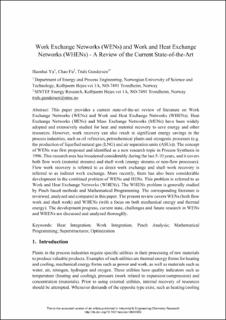Work Exchange Networks (WENs) and Work and Heat Exchange Networks (WHENs): A review of the current state of the art
Peer reviewed, Journal article
Accepted version

Åpne
Permanent lenke
https://hdl.handle.net/11250/2676771Utgivelsesdato
2020Metadata
Vis full innførselSamlinger
Originalversjon
Industrial & Engineering Chemistry Research. 2020, 59 (2), 507-525. 10.1021/acs.iecr.9b04932Sammendrag
This paper provides a current state-of-the-art review of literature on work exchange networks (WENs) and work and heat exchange networks (WHENs). Heat exchange networks (HENs) and mass exchange networks (MENs) have been widely adopted and extensively studied for heat and material recovery to save energy and other resources. However, work recovery can also result in significant energy savings in the process industries, such as oil refineries, petrochemical plants, and cryogenic processes (e.g., the production of liquefied natural gas (LNG) and air separation units (ASUs)). The concept of WENs was first proposed and identified as a new research topic in process synthesis in 1996. This research area has broadened considerably during the last 5–10 years, and it covers both flow work (material streams) and shaft work (energy streams or nonflow processes). Flow work recovery is referred to as direct work exchange and shaft work recovery is referred to as indirect work exchange. More recently, there has also been considerable development in the combined problem of WENs and HENs. This problem is referred to as work and heat exchange networks (WHENs). The WHENs problem is generally studied by pinch based methods and mathematical programming. The corresponding literature is reviewed, analyzed, and compared in this paper. The present review covers WENs (both flow work and shaft work) and WHENs (with a focus on both mechanical energy and thermal energy). The development progress, current state, challenges, and future research in WENs and WHENs are discussed and analyzed thoroughly.